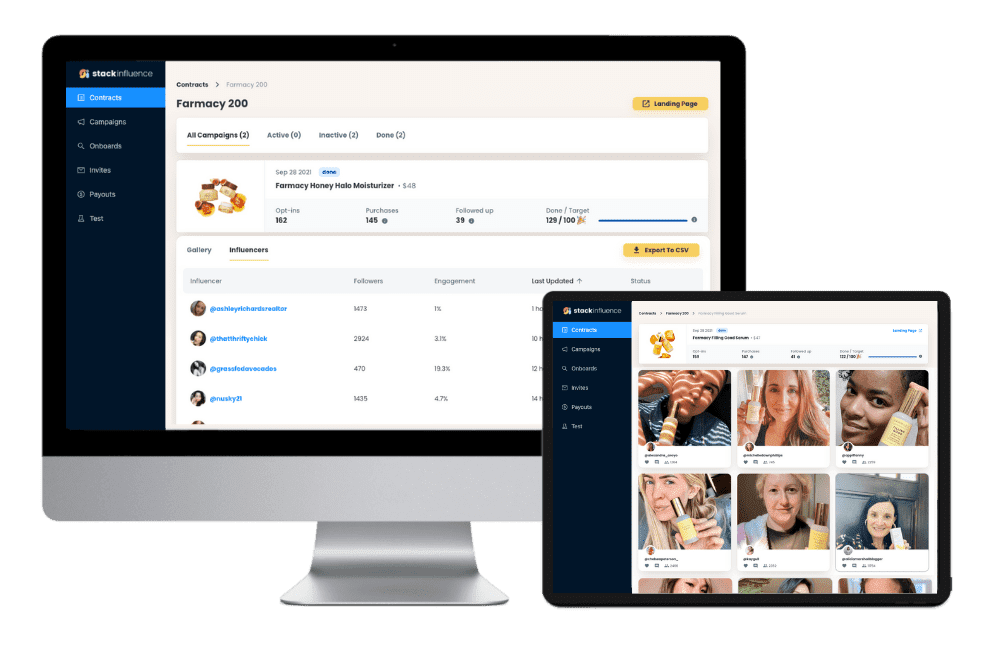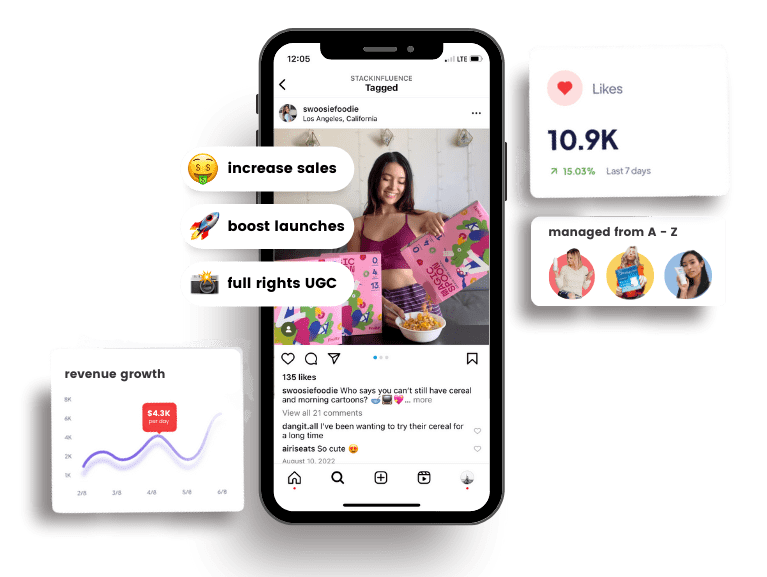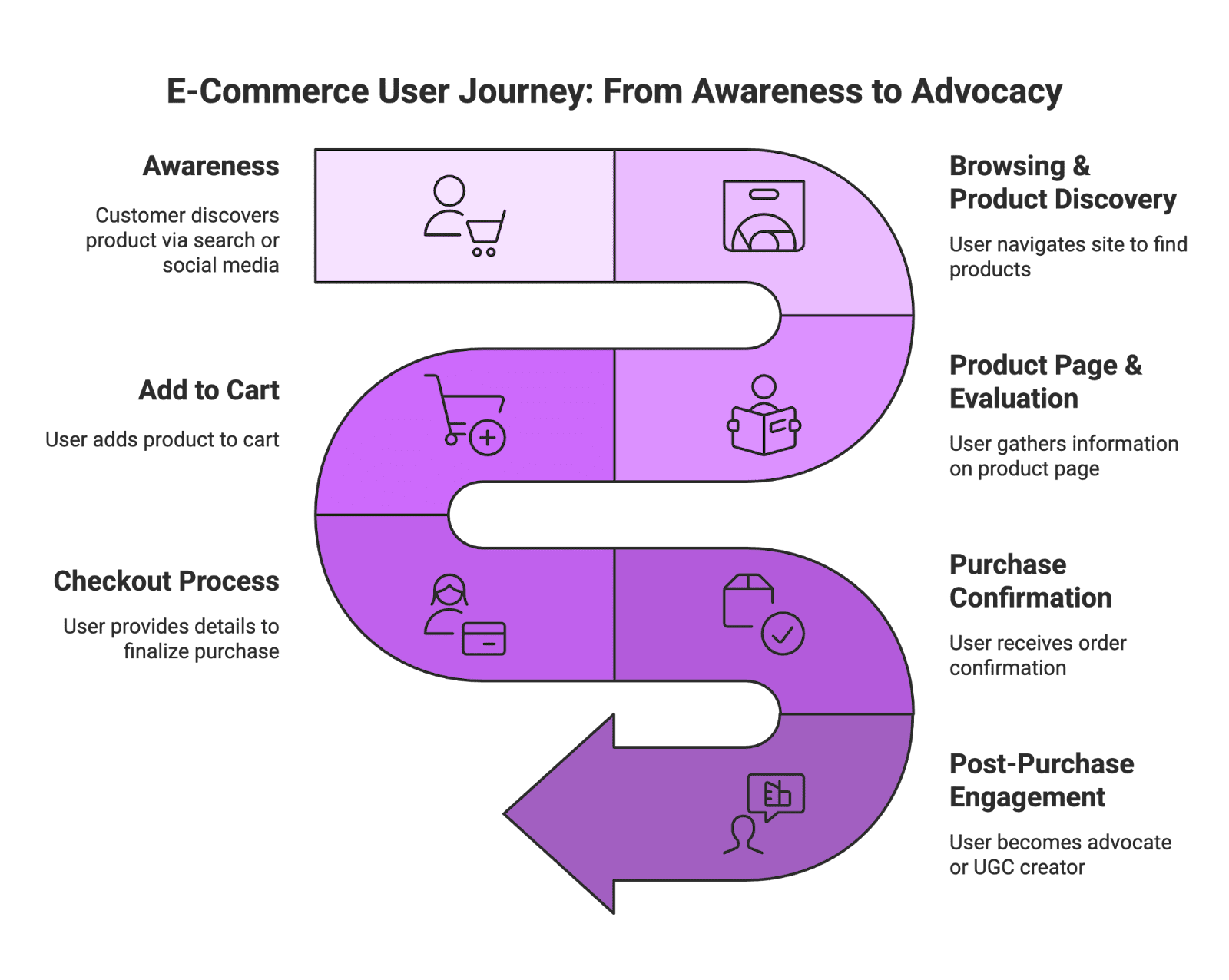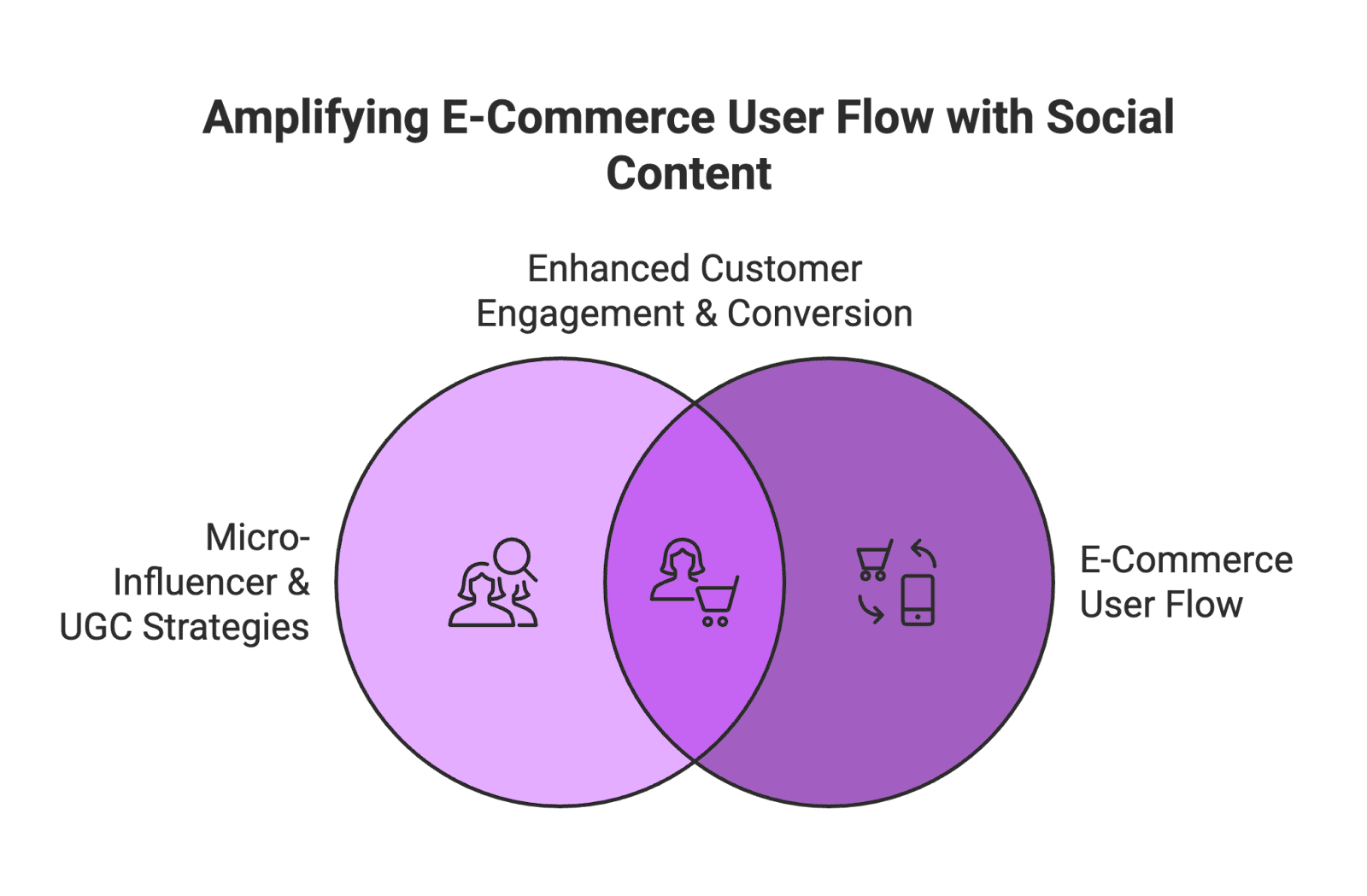What Is E-Commerce User Flow?
11th
August, 2025
Influencer Marketing
Amazon Marketplace
Artificial Intelligence
TikTok Tips
In the ultra-competitive world of e-commerce, understanding your website’s user flow is crucial for converting visitors into customers. Whether you’re an Amazon seller or a brand leveraging micro-influencers, content creators, and user-generated content (UGC) for marketing, mapping out the e-commerce user flow can dramatically improve your results. From the first click (often driven by social media buzz or influencer recommendations) to the final checkout, every step of the customer’s journey needs to be smooth and optimized. In this comprehensive guide, we’ll break down what e-commerce user flow means, why it matters, and how to optimize it – including tips for beginners and advanced marketers alike, plus insights on integrating micro-influencer and UGC strategies (with a nod to platforms like Stack Influence that help brands scale these efforts).
Understanding E-Commerce User Flow
User flow refers to the path or sequence of steps that a user takes to complete a goal on your website. In an e-commerce context, this typically means the journey from first arriving on your site (or product page) all the way through to making a purchase (and beyond). In simple terms, an e-commerce user flow is “the steps a user takes through your website to complete a particular task,” such as discovering a product or buying an item. It’s essentially a map of the customer’s journey on your online store.
Critically, e-commerce user flows are tied to the stages of the customer lifecycle – from initial awareness to final decision. If you can’t guide users from landing page to purchase, then all the traffic in the world won’t boost your sales. A well-designed user flow ensures that at each stage (browsing, product viewing, adding to cart, checkout, etc.), the user’s experience is intuitive and free of friction. The result? More people complete their purchase instead of dropping off halfway.
Key point: E-commerce user flows differ from, say, a content blog’s user flow because they’re transaction-focused – the goal is to smoothly lead a customer toward buying something. Every extra click, confusing page, or distraction in the flow is an opportunity for the user to abandon the process. In fact, industry research shows that on average around 70% of online shopping carts are abandoned without purchase. That means the majority of shoppers start the buying process but don’t finish it – often due to obstacles or hesitation during the user flow. This is why optimizing each step of the funnel is so important for e-commerce success.

Unlock the Power of Micro Influencers and Elevate your Brand Today!

Typical Steps in an E-Commerce User Flow

While user flows can vary depending on the business and product, most e-commerce customer journeys include similar core steps. Below is a breakdown of a typical user flow for an online store, from the visitor’s entry point through conversion and beyond:
- Entry/Awareness: The customer’s journey often begins off-site. They might discover your product or brand via a Google search, an ad, a social media post, or a recommendation from a micro-influencer. For example, a content creator on Instagram might showcase your product, prompting users to click a link to your site. This is the awareness stage, where the user decides to visit your online store. It could be your homepage or a specific landing page (for instance, a product page if they clicked a direct link).
- Browsing & Product Discovery: Once on your site, the user navigates around. They might land on the homepage or a category page, use the menu or search bar to find products, or scroll through listings. The site’s navigation and layout should cater to both casual browsing and focused searches. This stage is about helping the user find a product of interest with minimal effort. Clear category labels, search filters, and personalized recommendations can guide the user effectively.
- Product Page & Evaluation: After finding an interesting item, the user views a product page. This is a critical point in the flow – the user is gathering information to decide if the product meets their needs. The product page typically provides photos, descriptions, specifications, pricing, and importantly, social proof like ratings, reviews, or even UGC examples. Content here can make or break the purchase decision. For instance, seeing positive user-generated content (e.g. photos from other customers or testimonials from micro-influencers) can build trust. Shoppers tend to trust “people like them”; indeed, 92% of consumers trust word-of-mouth and UGC more than traditional ads. So, featuring authentic reviews, photos, or videos from creators can reassure the user at this stage.
- Add to Cart: If the product looks appealing, the user clicks “Add to Cart.” This move indicates intent to purchase, but it’s not a done deal yet. After adding an item to the cart, some users will continue browsing for more products, while others proceed directly to checkout. It’s important that the cart experience is smooth – e.g. showing a confirmation that the item is added, the cart total, and an easy-to-find checkout button. Any confusion here can derail the momentum.
- Checkout Process: In the checkout, the user provides necessary details (shipping address, payment info, etc.) to finalize the purchase. This step must be as streamlined as possible because it’s notorious for losing customers if it’s too long or complicated. Remember that ~70% cart abandonment rate? Many drop-offs happen at checkout due to friction or doubts. Best practices include offering guest checkout (no forced account creation), multiple payment options, displaying trust badges, and perhaps showing a summary of benefits (“Free shipping” or “Easy returns”) to keep the user confident. This stage is all about reducing anxiety and effort.
- Purchase Confirmation: If all goes well, the user completes the purchase and lands on a confirmation/thank you page. This page confirms the order and often provides details like order number and what to expect next (shipping info or receipt via email). While the conversion has technically happened, this page is still part of the user flow and can be optimized – for example, suggesting related products for future, or encouraging the customer to share their purchase on social media (post-purchase engagement).
- Post-Purchase (Retention & UGC): After the purchase, the user flow can continue into post-purchase interactions. Savvy e-commerce brands consider this part of the journey too. Follow-up emails, requests for reviews, or prompts to share a photo of the product on social media all come into play here. If a customer leaves a review or shares UGC (like an unboxing video or Instagram post of the product in use), that content becomes valuable input for other customers’ future user flows. It’s a virtuous cycle: a UGC creator (often an everyday customer or micro-influencer) might post their experience, which feeds back into the awareness stage for new potential customers. In essence, a satisfied buyer can turn into an advocate or content creator, helping bring in new shoppers.
Example of an e-commerce user flow from initial awareness to post-purchase stages. The flow starts with a user discovering the site (often via search, social media, or an influencer’s link), then browsing and viewing a product, adding it to the cart, proceeding through checkout, and finally completing the purchase. Post-purchase actions (like leaving a review or sharing UGC on social platforms) feed back into the cycle by influencing future shoppers.
Why Optimizing User Flow Matters (Conversion & UX)
Optimizing your e-commerce user flow is directly tied to higher conversion rates and a better user experience (UX). Each stage of the flow is a potential drop-off point, so smoothing out the journey can yield significant gains. Let’s consider a hypothetical funnel of 100 visitors entering an online store:
Example of an e-commerce conversion funnel, illustrating the percentage of users remaining at each stage (hypothetical data). Out of 100 visitors to the site, a fraction view a product, an even smaller fraction add an item to the cart, and ultimately only a percentage complete the purchase. Many users drop off at each step, which is why optimizing the flow at every stage is crucial.
In the example funnel above, only 10% of visitors ended up purchasing (a number not far from reality for many sites). This drop-off happens for various reasons: some visitors aren’t ready to buy, but many could have purchased if their experience was better. Common pain points include unclear navigation, slow-loading pages, lack of trust, or a complicated checkout process. By identifying and fixing these issues, you reduce friction. Even modest improvements at each step can add up to a big increase in overall conversion. For instance, simplifying the checkout form or adding more payment options might reduce cart abandonment. (It’s worth noting again that roughly 70% of shoppers abandon carts before completing checkout – a metric that good UX design aims to improve upon.) For brands that want to take their optimization efforts further, it can also help to hire UX designers from Toptal who specialize in crafting seamless e-commerce experiences.
Moreover, optimizing user flow isn’t just about preventing negatives (drops or abandons); it’s also about encouraging positives – guiding and persuading the user onward. This is where elements like design, copywriting, and social proof intersect with user flow. If a user is on the fence about a product, seeing a high star rating and some glowing reviews or UGC images can nudge them to click “Add to Cart.” In fact, 81% of consumers have considered purchasing a product after seeing friends, family, or influencers post about it on social media. If you have a healthcare website, partnering with a healthcare design agency helps translate these same persuasion principles into compliant, patient-centered flows that build trust and improve conversions. That’s a powerful reminder that purchase decisions are often influenced by content and community, not just the product page itself.
Here are a few best practices and tips to optimize key parts of your e-commerce user flow (from first impression to finish):
- Speed & Simplicity: Ensure your pages load fast and the path to purchase is as short as possible. Every extra second of load time or convoluted step can cost you customers. Streamline menus, minimize clicks needed to find popular products, and keep the checkout steps few and straightforward (e.g., combine information on one page if possible, and avoid surprise extra fees at the end).
- Clear Calls-to-Action (CTAs): Guide users with obvious next steps. Buttons like “Shop Now”, “Add to Cart”, and “Checkout” should be prominently displayed and easy to find. Don’t make a user hunt for the cart icon or the checkout link – it should grab their attention when they’re ready to buy.
- Mobile Optimization: A huge portion of e-commerce traffic is on mobile devices, so your user flow must be mobile-friendly. Responsive design, easy-to-tap buttons, and mobile-specific payment options (like Apple Pay/Google Pay) can significantly improve flow for smartphone shoppers. A clunky mobile UX will cause users to give up quickly.
- Trust Signals & Social Proof: Build trust at critical decision points. This includes showing product reviews, ratings, customer photos, and even influencer endorsements or badges (“As seen on Instagram” or “Popular on TikTok” for example). Trust signals also mean having clear return policies, secure payment badges, and customer support visible. Shoppers are more likely to continue if they feel your site is credible and others have had positive experiences. As mentioned earlier, authenticity is key – nearly 90-92% of consumers prioritize authenticity when choosing brands, so genuine UGC can be more persuasive than polished ads.
- Personalization: Where possible, use data to personalize the flow. For returning visitors, show them items they viewed before or related recommendations. For new visitors, tailor the homepage or landing content based on how they arrived (for instance, if they clicked an influencer’s link about “fitness gear”, show fitness-related products up front). A personalized experience makes the shopping process feel relevant and helps users find what they want faster.
- Testing and Analytics: For advanced optimization, continuously analyze how users move through your site. Tools like Google Analytics or specialized funnel analysis software can show you where drop-offs happen most. A/B test changes to see if they improve the flow – such as testing a one-page checkout vs. multi-step, or different placements of reviews on the product page. Data-driven tweaks can incrementally boost your conversion rate over time. Data-driven tweaks can incrementally boost your conversion rate over time, and working with a custom software agency can help implement tailored e-commerce solutions to further optimize user flow and performance.
By focusing on these areas, you address both the qualitative aspect (user satisfaction) and the quantitative aspect (higher conversion percentages) of an effective user flow. The end result is a win-win: shoppers enjoy a seamless experience, and you enjoy more sales.
The Role of Micro-Influencers and UGC in the User Flow

Now, let’s talk about those special keywords: micro-influencers, UGC, content creators, and how they intersect with e-commerce user flow. At first glance, you might think influencer marketing and UX design are separate topics – one is about driving traffic and social buzz, while the other is about on-site navigation and conversion. In reality, they work hand-in-hand. Influencer and user-generated content strategies can turbocharge each stage of the user flow by enhancing awareness, trust, and engagement.
Here’s how micro-influencers and UGC fit into the e-commerce user journey:
- Awareness & Traffic (Top of Funnel): Micro-influencers – social media personalities with smaller but highly engaged followings – are excellent at creating initial awareness for products. For e-commerce brands (including Amazon sellers), partnering with micro-influencers means your product can be introduced to niche communities in an authentic way. A recommendation or shout-out from a micro-influencer can send a wave of interested visitors to your site or Amazon listing. Unlike generic ads, these come with built-in credibility; followers see it more as advice from a trusted friend than a sales pitch. For example, an Amazon seller might use a micro-influencer on YouTube to review a gadget, generating interest and clicks from that influencer’s audience. These new visitors enter your user flow already warmed-up by the influencer’s trust factor.
- Consideration & Trust-Building (Mid Funnel): Once the visitor hits your site or product page, UGC and influencer content continue to play a role. This is the consideration stage where the user is weighing the decision. Embedding UGC on your site – such as Instagram photos of real customers using the product, or testimonial videos – can significantly boost credibility. Social proof is one of the strongest motivators in e-commerce; people want to know that others have bought and liked the product. According to data, 81% of consumers have been influenced by seeing friends, family, or influencers post about a product (essentially a form of UGC) when considering a purchase. By featuring that kind of content on your product pages or ads, you’re catering to this psychological need for validation. Even on marketplaces like Amazon, we see this principle: listings with lots of reviews, customer images, and answered questions (all UGC elements) convert far better than those without. Shoppers often scroll straight to review images or videos on Amazon to gauge real customer experiences, and 95% of consumers read product reviews before buying. In short, UGC reduces uncertainty, making the user more comfortable to proceed to “Add to Cart.”
- Conversion & Decision (Bottom Funnel): When it comes to sealing the deal – getting that checkout complete – micro-influencers can help here as well, albeit indirectly. Sometimes influencers share discount codes or limited-time offers for their followers, which can be the final nudge to convert a hesitant user. Additionally, the overall sentiment a customer has due to influencer and UGC exposure can influence conversion. If a user has seen your product recommended multiple times by creators they trust, by the time they’re on the checkout page, they’re likely more confident in hitting “Buy now.” It’s worth noting that even external influencer content can drive sales; 51% of consumers have made a purchase after seeing a product used by an influencer online. That means a significant portion of your conversions might actually be attributed to pre-site influence. By integrating those campaigns (for instance, having influencers remind users to use your site/app or providing affiliate links), you make the transition from influence to purchase seamless.
- Post-Purchase Advocacy: After a purchase, micro-influencers and UGC come full circle. Encouraging customers to share their experience (perhaps by featuring UGC in your marketing or creating campaigns where customers can get featured) helps generate fresh content. Some of your customers might even become micro-influencers or brand ambassadors if they love your product. Many modern brands run programs to send free samples to micro-influencers or incentivize UGC creation – essentially treating UGC as an extension of the user flow that feeds new users into the top of the funnel. Platforms like Stack Influence (along with others) make it easy to connect with everyday creators and micro-influencers at scale. By seeding products to a network of micro-creators, you can quickly gather a library of authentic content – unboxing videos, lifestyle photos, reviews – which can then be repurposed on your site, social media, or Amazon listings. This not only drives volume of content (important for keeping things fresh and for SEO), but also provides a continuous loop of social proof. The SEO benefits are notable too: a site or Amazon listing sprinkled with UGC (reviews, Q&A, photos) naturally accumulates more keywords and engagement, potentially boosting search rankings and dwell time.

Unlock the Power of Micro Influencers and Elevate your Brand Today!

Benefits of Integrating Micro-Influencers & UGC in Your User Flow
To summarize the impact, here are some key benefits and outcomes when you effectively weave micro-influencer marketing and UGC into your e-commerce strategy:
- Authenticity & Trust: UGC and micro-influencer content make your brand feel more authentic. People trust real voices more than corporate messages. In fact, 92% of consumers trust recommendations from people (even strangers) over brand ads. By showcasing content from real users and creators, you instantly boost the trust factor, which helps keep potential customers moving through the flow rather than bouncing off due to skepticism.
- Social Proof & Engagement: When shoppers see others (peers or creators) using and loving a product, it creates powerful social proof. This can heavily influence purchase decisions and also increase on-site engagement. Shoppers spend more time, interact with UGC (e.g., watching a quick unboxing video on the page), and feel more confident. One survey found 81% of consumers have considered or purchased a product after seeing friends, family, or influencers post about it. UGC essentially acts as digital word-of-mouth, validating the product’s value.
- Content Volume (at Lower Cost): Sourcing content constantly can be expensive if you rely only on professional shoots or big ad campaigns. Micro-influencers and UGC creators provide a steady stream of relatable content more affordably. Instead of one glossy commercial, you could get 10 different authentic product photos or videos for the same budget. Many brands use platforms (like Stack Influence or others) to automate this process, getting dozens of UGC pieces from everyday creators. More content means you can refresh your site and ads frequently and even run A/B tests to see which style of UGC converts best. It’s a scalable way to enrich every stage of the user flow with fresh, relevant content.
- Higher Conversion Rates: The end game is more sales, and UGC/influencer content can directly contribute to that. By addressing customer concerns and building trust, these elements push hesitant buyers over the finish line. There’s evidence to back this up: one report recorded about a 29% increase in web conversions when websites featured user-generated content. Additionally, as noted, strong UGC presence (like lots of positive reviews and photos) on Amazon can improve the conversion percentage on those listings. When your funnel includes social proof at critical junctures, users feel more informed and confident clicking “Buy”. Even off-site, leveraging influencers to demonstrate the product can drive more people to convert once they land on your site – 51% of shoppers have purchased a product after seeing it used by an influencer. All this shows that weaving UGC and influencer touchpoints into your marketing funnel can directly boost sales performance.
- Broader Reach (via Niche Communities): Micro-influencers, by definition, each have their own niche followings – whether it’s a local community or a specific interest group (beauty enthusiasts, tech gadget fans, fitness buffs, etc.). Tapping into a network of micro-influencers allows an e-commerce brand to reach multiple micro-audiences that it might never capture with general advertising. Collectively, influencer content creators now reach a vast majority of consumers (one stat notes they reach about 83% of social media users aged 18-60 in total). For Amazon sellers, this broader reach can translate into more external traffic driven to your Amazon product pages (which can also boost your rankings on Amazon due to increased sales velocity). Essentially, integrating micro-influencers into your strategy casts a wider net for pulling people into your user flow, all while keeping the messaging authentic and targeted.
Incorporating micro-influencer and UGC strategies doesn’t replace good UX design and solid fundamentals – rather, it enhances them. Think of it this way: a great website user flow removes barriers and smooths the path, while influencer and UGC content adds fuel to the journey, motivating and reassuring users as they move along. Brands that master both are positioning themselves for maximum conversion potential.
Conclusion
Understanding what e-commerce user flow is and why it matters is the first step toward optimizing your online business for more sales. It’s all about seeing your website through the eyes of your customer: from the moment they discover you (perhaps via a micro-influencer’s Instagram post or a Google search) to the moment they complete a purchase (and even beyond, as they ideally become repeat buyers or advocates). By carefully designing each step of this journey – and continuously refining it through data and user feedback – you ensure that fewer customers slip through the cracks.
Remember that modern e-commerce is not just about a slick website in isolation; it’s about the ecosystem of influence and experience. Leveraging micro-influencers, content creators, and UGC can significantly amplify the effectiveness of your user flow. These elements build the trust and authenticity that keep users engaged and confident as they move toward checkout. As we’ve seen, shoppers crave authenticity and social proof – and integrating those into your funnel can yield tangible lifts in conversion rates and customer loyalty.
For beginners, start with mapping out your current user flow. Identify the pages and steps a typical customer goes through and note where you might be losing them. Tackle obvious pain points first (slow pages, confusing layout, etc.). For more advanced marketers, delve into analytics and experiment with incorporating UGC or influencer content at various touchpoints. You might A/B test showing a testimonial video on the product page, or adding an influencer quote on your landing page, to see if it boosts engagement. Continually iterate on both the UX side (flow, design) and the content side (UGC, social proof).
In summary, e-commerce user flow is the backbone of your online sales process. When optimized in tandem with savvy marketing (like micro-influencer campaigns and UGC integration), it creates a powerful synergy – more people find you, more of them trust you, and more end up clicking that “Purchase” button. By investing in a smoother user experience and authentic content, you set your brand up not only for higher conversions but also for long-term customer satisfaction and word-of-mouth growth. And as platforms like Stack Influence demonstrate, scaling up these micro-influencer and UGC efforts has never been more accessible for brands of all sizes. Here’s to creating user flows that not only convert better but also delight your customers at every step of the journey!

By William Gasner
CMO at Stack Influence
William Gasner is the CMO of Stack Influence, he's a 6X founder, a 7-Figure eCommerce seller, and has been featured in leading publications like Forbes, Business Insider, and Wired for his thoughts on the influencer marketing and eCommerce industries.
Want new articles before they get published? Subscribe to our Awesome Newsletter.
stack up your influence
turning creativity into currency
our headquarters
111 NE 1st St, Miami, FL 33132
our contact info
[email protected]
stack up your influence
turning creativity into currency
our headquarters
111 NE 1st St, 8th Floor
Miami, FL 33132


